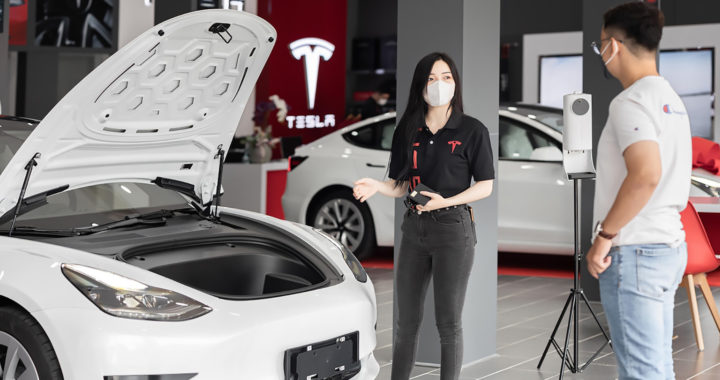Unlike most automakers, which depend on dealers to reach and sell vehicles to their target customers, Tesla does not use a traditional dealership model in its distribution strategy and overall marketing strategy. The company owns and operates a network of physical stores. It also sells its products via its online store. This is a direct-to-consumer or direct sales approach. Certain aspects of its distribution strategy also complement other elements of its marketing mix like its product strategy and promotion strategy.
Exploring and Explaining the Distribution Strategy of Tesla
1. Strategic Principles
Remember that the distribution strategy of Tesla centers on a direct sales approach. There are several reasons for its decision to move away from the traditional dealership model that has been popular across the entire automobile industry. Take note of the following:
• Electric Vehicle Focus: The company is a pioneer in the electric vehicle market segment. It introduced its first electric vehicles at a time when traditional dealerships had little knowledge about electric vehicles and limited experience in selling these novel vehicles to the intended target customers of the company. Using dealers could have limited the need for Tesla to educate the public about the capabilities of its electric vehicles, the benefits of owning one, and the specific unique selling propositions or perks and privileges that come with purchasing a Tesla vehicle.
• Product Diversification: It is important to note that Tesla has considered itself a tech company. Its stated mission and vision center on its aim of accelerating the global transition to sustainable energy. Hence, aside from electric vehicles, it also develops and markets energy storage products like lithium-ion batteries and renewable energy products like photovoltaic or solar energy systems. These products cannot be sold through dealers. The better option is to have consolidated channels of distribution channels to sell all of its products and position itself as a clean energy company.
• Customer Experience: Another reason why the distribution strategy of Tesla is based on a direct sales approach is that it wants to focus on providing an excellent customer experience. Hence, similar to companies like Apple, it invests in its stores to provide a unique and positive experience. Owning and operating its physical stores means controlling the customer experience. Take note that the company also maintains and expands a network of service centers for after-sales services and charging stations for recharging electric vehicles in key geographic markets like the United States.
• Regulatory Challenges: Take note that there are jurisdictions in which existing laws prohibit or restrict automakers to sell directly to customers. These laws are meant to protect the interest of independent dealership businesses. However, because Tesla wants to focus on selling electric vehicles, promote its other clean energy products, and control the customer experience, it has chosen not to use a dealership model in its distribution strategy and instead owns and operates a network of physical stores. The company has faced legal challenges in some jurisdictions due to this direct sales model.
Tesla has taken into consideration the aforementioned strategic principles to turn its distribution strategy into one of its strengths and one of the sources of its competitive advantage. This strategy gives it an edge in the entire competitive landscape.
2. Distribution Channels
The direct sales approach seems like a straightforward model for distributing products. However, in the case of Tesla, there is some degree of complexity in its distribution strategy because of the nature of its products and its unique selling propositions. Take note of the following:
• Physical Stores: Remember that Tesla operates its own physical stores in North America, Europe, Asia, and Oceania. These stores serve as showrooms where prospective customers can view Tesla products and learn about their prices and features. The company places these stores in high-traffic areas like commercial centers or within a shopping district to maximize visibility and accessibility.
• Online Store: It also operates an online store accessible through its official website. The digital storefront enables prospects to configure their desired vehicles, select options, place an order, and provide special delivery instructions. The same storefront also provides customers with financing options, process documents, and complete the entire sales process while in the comfort of their homes.
• Service Centers: Most service centers are co-located within its physical retail stores. However, in certain areas, there are standalone service centers dedicated to providing after-sales services to Tesla customers. These centers handle maintenance, repairs, updates or upgrades, and inquiries. Remember that the company places emphasis on providing excellent customer service.
• Experience Centers: Another interesting part of the distribution strategy of Tesla is its experience centers. Most of these centers are also co-located within its retail stores but there are also standalone permanent and temporary experience centers located in certain areas. These centers allow prospects to test drive Tesla vehicles or test other Tesla products and learn more about the features of these products.
• Supercharger Network: The company has invested heavily in building and expanding further a network of charging stations in key geographic markets. These are collectively called Supercharger Network. They are similar to gas stations that enable vehicle owners to recharge their electric vehicles. These charging stations are located along major highways and in densely populated areas.
It is interesting to note that the entire distribution strategy of Tesla not only fosters sales and customer relations but also supports its entire marketing mix. Its retail stores and experience centers help in promoting further its products through customer education.
The service centers and Supercharger Network are an integral part of its product strategy. Tesla customers can access these channels as part of their perks and privileges. These channels are also part of the entire Tesla product ecosystem and Tesla experience.





